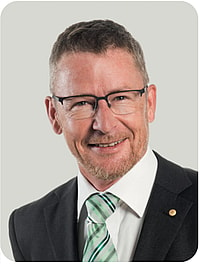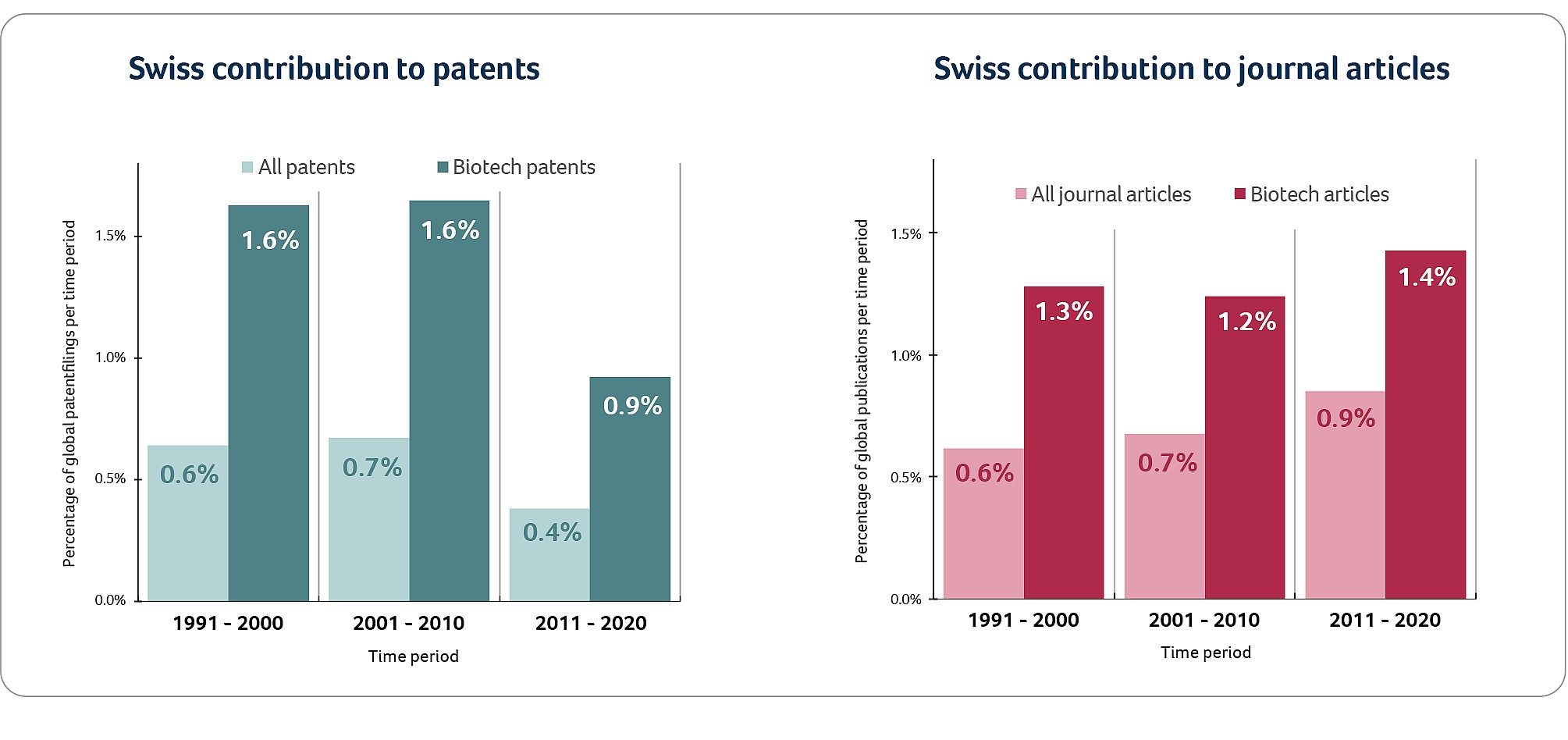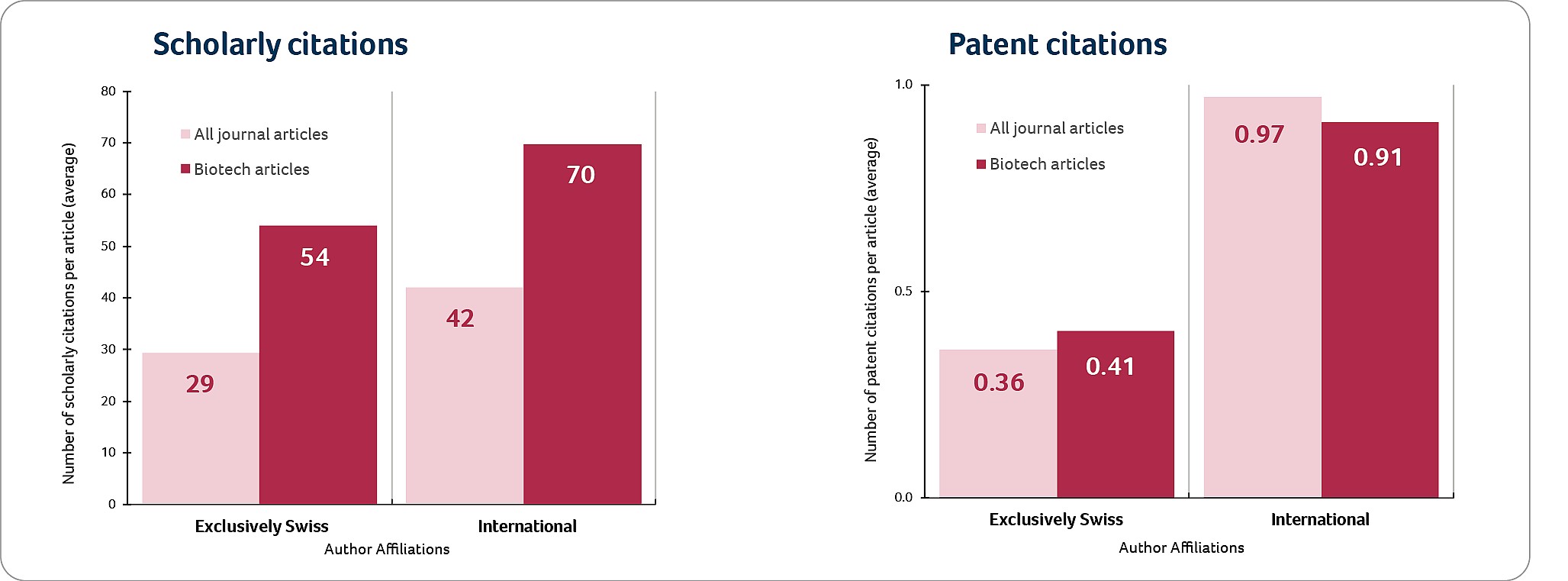- Get directions
- Leave a review
- Claim listing
- Bookmark
- Share
- Report
- prev
- next
- Monday, May 5, 2025 @ 11:00 am
Switzerland’s global influence in biotechnology research and innovation has continued to grow in recent decades. Two thirds of journal articles with a Swiss author include international partners, and there is a strong correlation between international collaboration and quality as measured by citation frequency. Biotechnology articles from Swiss institutions are cited most frequently, both in scientific publications and in patents.

Christian Moser Nikles
Swiss Federal Institute of Intellectual Property | Patent Expert

Christel Aebischer
Swiss Federal Institute of Intellectual Property | Patent Expert
For the past 14 consecutive years, Switzerland has been ranked as the world’s most innovative economy according to the Global Innovation Index (GII). Among the more than 80 indicators used in the GII ranking, patents and scientific publications are included in the category ‘knowledge and technology output’. Whereas patents have been the focus in previous Swiss Biotech Reports, this year’s article aims to show Switzerland’s footprint in the scientific literature in the field of biotechnology, based on data extracted from the free online database The Lens.
Scientific publications represent the visible output of research activities, in particular for public research institutions such as universities. However, from an economic perspective, the most important function of universities remains the education of the next generation of competent professionals. For this reason, the GII ranking also includes several indicators for the quality of education, including university rankings.
Scientific publications come in various forms, and journal articles account for around 70% of them. The data presented in this article was restricted to journal articles only, in order to exclude publications with incomplete records or lacking peer review, such as preprints or conference abstracts.
The biotechnology sector has grown rapidly and consistently during the past 50 years, as illustrated in Figure 1. Throughout this period the number of journal articles published has exceeded the number of new patents filed more than tenfold. Globally, both the number of patents filed and the number of journal articles published per year have tripled in the past 20 years.

journal articles, not with patents
Journal articles published by Swiss institutions match the global growth. In contrast, the number of patent filings assigned to inventors with residence in Switzerland increased rapidly from 1990 to 2006 but has remained at the same level since then.
In Figure 2, the bars represent the proportion of Swiss contributions to the global patent filings (left panel) and journal articles (right panel). For patents, ‘Swiss contribution’ means that at least one inventor is a Swiss resident. For journal articles, ‘Swiss contribution’ means that at least one author is affiliated with a Swiss institution or company.
The Swiss contribution in the biotechnology field is substantially higher than the average over all sectors. This applies equally to patent filings and journal articles, and to all three decades shown in the analysis.

As already evident in Figure 1, the Swiss contribution in patent filings has decreased in the last two decades, due to stagnation since 2006. In contrast, the Swiss contribution to journal articles has further increased.
From 2011 to 2020, 13% of the 43 million journal articles published worldwide related to biotechnology. This proportion is around 20% for articles originating from North America, Japan, China, and many European countries including Switzerland, with only subtle differences between these countries and regions.
In the same period, over 16 million patents were filed worldwide, and 2.5% thereof relate to biotechnology. Of the 63’000 patents with at least one inventor from Switzerland, 5.6% concern biotechnology.
In Figure 3, the bars represent the average number of scholarly citations (left panel) and of patent citations (right panel) received per journal article of Swiss origin between 2011 and 2020. ‘Exclusively Swiss’ means that all authors are affiliated with Swiss institutions, while the category ‘International’ comprises articles from Swiss institutions in collaboration with institutions from abroad. The average number of citations received is a way to measure the quality of a set of publications. More sophisticated quality indicators would include the journal impact factors, both of the papers themselves and of the citing papers. However, these data are not accessible on The Lens.
Among the journal articles of Swiss origin, those in the field of biotechnology receive significantly more scholarly citations than papers in other fields, but not more patent citations.
Journal articles with international authorship receive consistently more citations than those with exclusively Swiss authorship. This applies to both scholarly and patent citations, and to the biotechnology subset as well as to all papers.

The bubble graphs in Figure 4 show the top 25 countries of origin for journal articles in the biotechnology sector for 2011 to 2020.
The proportion of articles with international authorship is plotted against the average number of citations received per paper, either from journal articles (left panel) or from patents (right panel). The bubble sizes represent the total number of papers published per country between 2011 and 2020.
Switzerland (CH) features the highest level of international collaboration, closely followed by other smaller European countries, such as Sweden, Belgium, Austria, Denmark, and the Netherlands. The papers from these European countries receive almost as many scholarly citations as papers from Switzerland. In contrast, journal articles originating from the US rank second after Switzerland in terms of patent citations received.
Both graphs show a high degree of consistency with the patent data published in the Swiss Biotech Report 2023 (Page 20), although the latter is based on a completely different data set.

Discussion and conclusions
What has been shown for patents in previous Swiss Biotech Reports is also true for scientific publications:
- For journal articles in the biotechnology sector the contribution from Swiss institutions is significantly higher than in other disciplines.
- Two thirds of these papers result from collaborations with international partners, which is the highest proportion among the top 25 countries of origin for biotechnology papers.
- Biotechnology papers from Swiss institutions receive the highest average number of citations, both from scholars and in patents.
Journal articles and patent applications in the biotechnology sector are very distinct with regard to authors and affiliations. Within the Swiss subset, more than 80% of the journal articles originate from universities and research institutes, and fewer than 20% involve authors from companies. In contrast, 95% of the patents are filed by companies, including 20% filed together with universities. Fewer than 5% of the patents are filed by universities alone.
Despite these differences, the correlation between international collaboration and quality measured by citation frequency is strikingly similar for both journal articles and patents.
Although many other factors may contribute to the output quality, the degree of international collaboration appears to have a significant impact. The small size of Switzerland is probably a factor that encourages Swiss institutions and companies to seek international collaborations. However, access to international partners also requires proven scientific excellence. The reputation of Swiss research institutes means that they are welcomed as partners in prestigious international networks. In turn, the active participation in such networks enables Swiss institutions to continue to generate high quality output, and to further consolidate their position as excellent schools educating the next generation of professionals in biotechnology and other disciplines.
Methods
JOURNAL ARTICLES
The journal articles were retrieved from The Lens, using a comprehensive keyword concept targeting biotechnology. The keyword search was restricted to the text fields title, abstract, keyword, or field of study. The results were further restricted by filtering for the document type journal article, resulting in a pool of over 15 million biotechnology related journal articles.
To determine the accuracy of the collection, 100 articles out of the 5.4 million articles published between 2011 and 2020 were randomly sampled and individually reviewed. 94 of these 100 documents were related to biotechnology.
The country-specific analysis was performed using the filter Institution Country/Region. To determine the proportion of publications without contributions from other countries, the top 30 countries other than the selected country origin were excluded. This subset was then subtracted from the total for each country to obtain the complementary subset representing the journal articles generated by international collaboration.
PATENT DATA
Patents were captured by the established patent classification filter for biotechnology using the patent analysis tool PatentSight. The filter Origin of Inventor was used to identify the subset of patents invented in Switzerland.
In all earlier contributions to the Swiss Biotech Reports, numbers of patents were based on active patent families at a given time point. For the present study, however, the patent families are presented according to their year of filing, regardless of their legal status, in order to better match patents and journal articles.
DATA ANALYSIS
The data retrieved from the databases was transferred to Microsoft Excel for further analysis and graph generation.
INTERESTED IN WORKING WITH THE LENS?
The IP Academy of IPI offers an introduction workshop for the Lens. https://www.ige.ch/en/services/ip-academy/workshops/ip-workshops-on-specific-topics